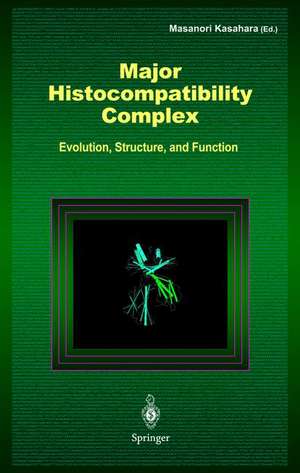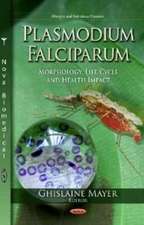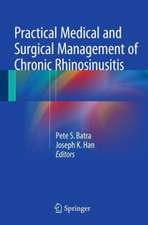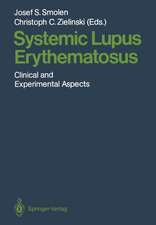Major Histocompatibility Complex: Evolution, Structure, and Function
Editat de M. Kasaharaen Limba Engleză Hardback – 31 ian 2000
| Toate formatele și edițiile | Preț | Express |
|---|---|---|
| Paperback (1) | 754.66 lei 6-8 săpt. | |
| Springer – 19 noi 2013 | 754.66 lei 6-8 săpt. | |
| Hardback (1) | 738.93 lei 6-8 săpt. | |
| Springer – 31 ian 2000 | 738.93 lei 6-8 săpt. |
Preț: 738.93 lei
Preț vechi: 777.82 lei
-5% Nou
Puncte Express: 1108
Preț estimativ în valută:
141.39€ • 147.62$ • 117.02£
141.39€ • 147.62$ • 117.02£
Carte tipărită la comandă
Livrare economică 05-19 aprilie
Preluare comenzi: 021 569.72.76
Specificații
ISBN-13: 9784431702764
ISBN-10: 4431702768
Pagini: 588
Ilustrații: XXIII, 561 p. 90 illus., 4 illus. in color.
Greutate: 0.99 kg
Ediția:2000
Editura: Springer
Colecția Springer
Locul publicării:Tokyo, Japan
ISBN-10: 4431702768
Pagini: 588
Ilustrații: XXIII, 561 p. 90 illus., 4 illus. in color.
Greutate: 0.99 kg
Ediția:2000
Editura: Springer
Colecția Springer
Locul publicării:Tokyo, Japan
Public țintă
ResearchDescriere
Every biological system is the outcome of evolution and has a history all its own. This history dictates how the system works and why it has certain properties and not others. This is why we need to study not only the structure and function, but also the history of the system. This argument undoubtedly applies to the study of the immune system and also to the study of the major histocompatibility complex (MHC). Since 1989, researchers of various scientific disciplines who share a deep inter est in MHC evolution have held a meeting every two years to discuss their latest research developments, exchange ideas, and foster friendship. Together with my colleagues Drs. Naoyuki Takahata and Yoko Satta, I organized the Sixth Interna tional Workshop on MHC Evolution in Hayama, Japan, May 25-29, 1999. This volume is the proceedings of that conference. It covers diverse topics pertinent to MHC evolution, including the origin of the adaptive immune system, the organi zation of the MHC in humans and other model vertebrates, MHC-parasite co evolution, and the nature and origin of MHC polymorphism. I hope that this book will be of interest not only for MHC researchers and immunologists, but also for other specialists who are interested in the evolution of biological systems in gen eral.
Cuprins
Origin of the MHC.- Jaws and AIS.- The MHC paralogous group: listing of members and a brief overview.- The MHC « Big-Bang » : duplication and exon shuffling during chordate evolution. A hypothetico-deductive approach.- Relationships among the genes encoding MHC molecules and the specific antigen receptors.- Conserved linkage among sea urchin homologs of genes encoded in the vertebrate MHC region.- Genome organization of the MHC.- Physical mapping of the class I regions of the rat major histocompatibility complex.- MHC gene organization of the bony fish, medaka.- Polymorphic olfactory receptor genes and HLA loci constitute extended haplotypes.- Distribution of polypurine/polypyrimidine tract sequences in the human MHC region and their possible functions.- Potential for paralogous mapping to simplify the genetics of diseases and functions associated with MHC haplotypes.- Transposable elements and the metamerismatic evolution of the HLA class I region.- Polymorphism in the HLA class I region.- Nucleotide diversity within the human major histocompatibility complex: function of hitchhiking effect, duplications, indels and recombination.- Function and evolutionary dynamics of MHC genes.- Proteasomes and MHC class I-peptide generation.- Comparative aspects of the MHC class I-related MR1, CD1D, and MIC genes in primates.- Rat TL and CD1.- Are chicken Rfp-Y class I genes classical or non-classical?.- Xenopus class I proteins.- Two MHC class II A loci in the channel catfish.- The evolution of MHC class I genes in cattle.- Evidence for four functional DQA loci in cattle with distinct distributions amongst European and African populations.- Natural killer gene complex.- The NKC and regulation of natural killer cell-mediated immunity.- MHC-pathogen coevolution.- Manipulation of MHC-encoded proteins by cytomegaloviruses.- An animal model for understanding the immunogenetics of AIDS virus infection.- MHC polymorphism.- Evolution of HLA-DRB loci, DRB1 lineages, and alleles: analyses of intron-1 and -2 sequences.- The non-coding regions of HLA-DRB uncover inter-lineage recombinations as a mechanism of HLA diversification.- Conversion or convergence? Introns of primate DRB genes tell the true story.- Intron 1 sequence analysis of the MHC-DRB1, 3, 4, 5, and 6 genes in five non-human primate species.- Evolution of Catarrhini DPB1 exon 2 under intragenic recombination.- The effect of mutation, recombination and selection on HLA non-coding sequences.- HLA-DQ haplotypes in 15 different populations.- HLA class I and class II loci in Pacific/Asian populations.- HLA class I alleles in Australian aborigines and their peptide binding profiles.- An evolutionary overview of the MHC-G polymorphism: clues to the unknown function(s).- MIC-A polymorphism and a MIC-A-MIC-B null haplotype with ~ 100-kb deletion.- Repertoire forecast of MHC class I binding peptides with peptide libraries.- Sequence conditions for gene conversion of mouse MHC genes.- Mhc class II genes of Darwin’s Finches: divergence by point mutations and reciprocal recombination.- Contrasting patterns of MHC and microsatellite diversity in social and solitary tuco-tucos (Rodentia: Ctenomyidae).
Caracteristici
Updated information on MHC genetics and evolution











